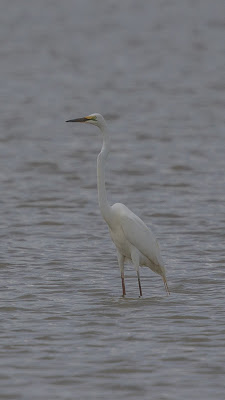Comparative Diagnostics:
In the bird guides it is "paired" with the Sharp-tailed Sandpiper; i.e. they look very similar.
- Pec: 21-23 cm long, has a streaked breast with an abrupt junction with a white belly. Sharpie: 20cm long with a diffuse margin to the breast.
- Pec: The bill is slightly decurved (curves downwards) and brown with a darker tip; i.e. the base is appreciably lighter than the tip. On the WTP bird, the base is quite yellow/orange and the easiest ID factor. Sharpie: Bill slightly decurved but less than Pec. Relatively dark along entire length.
- Pec: no eye-ring. Sharpie: prominent eye-ring.
- Pec: Supercilium (eyebrow) is buffer than Sharpie. Sharpie: often white and distinct.
These were the views that alerted me to the Pec's presence in the crake pond. You can easily see the abrupt junction of the breast with the white belly and the yellow base to the bill. It is hard to tell from images without other birds but, pond-side, there were a few Sharpies to compare the size and I was able to tell it was just a bit bigger than a Sharpie.
This is a Sharpie so you are able to compare the breast/belly junction and the bill colour.
Here is another comparison image with the Sharpie in front and the Pec behind.Pectoral Sandpiper Calidris melanotus


















































